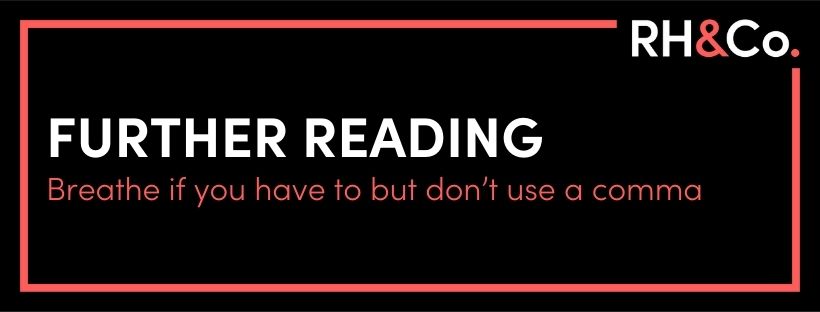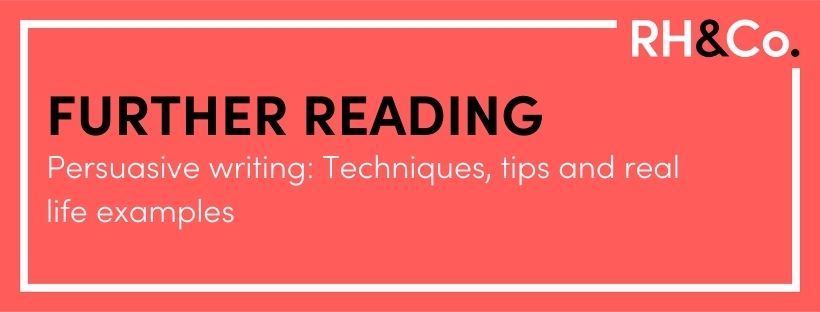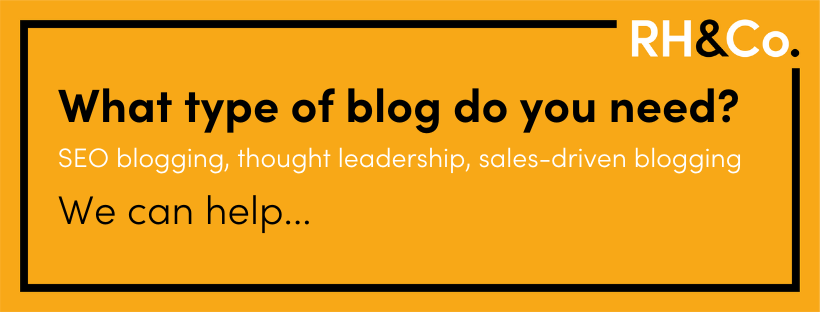For punctuation pedants, a misplaced apostrophe is the cause of much rage. Their blood boils at the sight of this elevated comma being used in the wrong place.
At RH&Co we try to stay mellow about it – after all, none of us can put together a change management plan or code even a single line of Javascript. Everyone has different skills, right?
But when it comes to business writing, it is important to get the basics right. While the odd typo is inevitable, consistently poor spelling, punctuation and grammar will mark you out as unprofessional.
Which is why we thought you’d appreciate this little guide on how to use an apostrophe correctly…
To replace missing letters
This is the most basic rule for apostrophes, so people usually get it right. When do not becomes don’t, the apostrophe takes the place of the second o. When they will becomes they’ll, it is there in the place of both the w and the i. This is what you call a common contraction. So far, so simple.

To signify possession
This bit also starts off in a relatively uncomplicated fashion. When Susan buys a book, it is Susan’s book. When the builder makes a sandwich, it is the builder’s sandwich. This is the possessive apostrophe at work.
What if the builder is really hungry and has two sandwiches? Same deal as with the singular form – the builder’s sandwiches. But what if there are several builders? Now we need to move the apostrophe so that it comes after the pluralising s: the (many) builders’ sandwiches.
The same goes for the Smith family. While Fido might be Mrs Smith’s dog (apostrophe before the s), he is also the Smiths’ dog – the dog belonging to the Smiths as a group – or the Smiths’s dog.
It’s worth noting that if the family’s surname ends with an s, you’ll need to pluralise it before adding the apostrophe. So while Mittens is Mr Williams’ cat, she is also the Williamses’ cat.
Just watch out for irregular nouns, which become plural in a way other than by adding an s or es – like child, which becomes children (rather than childs). If you want to refer to toys belonging to said children, you would say the children’s toys and not the childrens’ toys (because the plural of child is not childrens).
Still with us?

Its vs It’s
There is an exception to the possessive apostrophe: it. Since a sandwich belonging to a builder is the builder’s sandwich, it should follow that a sandwich belonging to it (say, a dog of non-specific gender) is it’s sandwich. This is an understandable and common mistake.
Instead, the dog would eat its sandwich. The bird would build its nest. A company would look after its staff and a plant would absorb water through its roots.
The only reason to add an apostrophe to its is if you’re using it as the contraction of it is ie it’s. In this case, the apostrophe signifies the missing i, as per rule number one above.If in doubt, try lengthening its to it is – if it doesn’t work, you don’t need an apostrophe. As an example, you wouldn’t say that the floppy disc has had it is day, therefore you should write the floppy disc has had its day, and not it’s day.
Acronyms
For some people, all of this is still relatively straight forward. Until they meet an acronym. Then for some reason they decide it’s time to throw the rulebook out of the window, and use an apostrophe before an s that is being used to create a plural, rather than to show possession.
So while they’d never say that one file becomes two file’s, they’ll happily talk about the garage that offers excellent MOT’s, the shortage of ATM’s in town, and how difficult it is to remember so many PIN’s. (Incidentally, this actually does make us feel quite twitchy.)Remember, unless you are signifying possession (the ATM’s screen or, if dealing with many ATMs, the ATMs’ screens) you don’t need that apostrophe.
Exceptions
We’re fairly certain that the English language was designed to confuse, which means you will always find an exception to any rule – including those relating to punctuation marks.
For example, if you wanted to say that when people’s handwriting is bad, their as often look like us, it’s probably helpful to add apostrophes to make your meaning clear: when people’s handwriting is bad, their a’s often look like u’s.
Likewise, you might want to write about the do’s and don’ts of using apostrophes (even though it’s actually incorrect) because it’s just clearer than dos and don’ts (which is the correct form). We like to call this a creative apostrophe.So there we have it. Not all that hard, is it? Feel free to copy and paste this post into your brand style guide! And if you’re still struggling with apostrophe confusion, email us and one of our punctuation nerds will set you straight.
There are many benefits of blogging for business. Well written blog posts can add real value for your audience while showing off the expertise in your business and driving traffic to your website – to name just a few.
But if you’re just starting out with creating a blogging strategy, it can be hard to know, well, where to start. There are just so many things to think about. Here are a few questions people ask us all the time and the answers we usually give them.
TL:DR
- How long should my blog posts be?
- How often should I blog?
- How often should I mention my keyword phrase?
- Do I need to use lots of images in my blog?
How long should my blog posts be?
Yes, it’s frustrating when people respond with, “How long’s a piece of string?” But the truth is that the length of your blog post will depend on a number of factors. For example, what is the subject of your post? Are you tackling a complex issue or showing off images of your latest products? Likewise, who is your audience – a busy parent trying to find a way to entertain the kids on a rainy weekend, or a CHRO looking at employee retention trends?
There are some general rules though. For example, a blog post should be a minimum of 300 words to satisfy search engines that you’ve actually got enough valuable content in there to make it worth directing people to the page. That said, many social posts these days are heading towards that number of words, so consider where the best place is to share those shorter pieces of content.
Google’s priority is serving people the most valuable content for any given search enquiry. That’s why they released the Helpful Content algorithm update. So yes, we can talk about keywords but let’s not be blinkered by them.
On the other end of the scale, there’s evidence that long form content – up to several thousand words – can be really effective for generating backlinks and social shares, for example. The trouble with these longer posts is that they’re harder to write. Keeping someone engaged for that length of time takes skill and practice.
So what’s the answer? We usually recommend aiming for 800-1,200 words as a good average. But really, write as much as the blog needs, no more, no less.
Top tip: Use your site’s analytic tools and experiment with different post lengths to see which ones get the best engagement. Remember, you need to set goals for your blog so you know exactly what to track!

How often should I blog?
Again, the answer isn’t as straightforward as a single number. In part, it depends on your reason for blogging. If you’re doing a big SEO push then you’ll want to create as much well written and well optimised content as you can – Hubspot suggests as many as 3-4 smaller posts and 4-5 larger ones each week!
Of course, not every business has the time or budget to put that many posts out. And that’s ok. Your strategy might be centred around establishing your brand authority with high quality thought leadership, in which case 2-4 posts per month may well be enough.
What we do say is that posting a blog less than twice a month is pretty much pointless. The impact of such infrequent content creation will be so minimal that you’re likely to give up well before you see positive results. Fortnightly is good, weekly is great and if you have the resources to do more, then brilliant, you’ll most likely see results that much more quickly.
Top tip: If you know you won’t be able to blog consistently, why not create a ‘resources’ page of evergreen* content with no date attached to each article. That way you can add to it when you’re able to but it never feels out of date. (*This just means it’s always relevant rather than linked to a particular current event).
How often should I mention my keyword phrase?
Before we get into this, let’s be clear about one thing: Google’s priority is serving people the most valuable content for any given search enquiry. That’s why they released the Helpful Content algorithm update. So yes, we can talk about keywords but let’s not be blinkered by them.
If you’re writing your blog in order to drive organic search traffic, you’ll need to be sure that you’ve got a solid SEO strategy in place. Even the most brilliantly optimised content is going to struggle if your page load times aren’t fast enough or you haven’t got the right security tags.
It’s important to understand which keywords you’ve got a chance of ranking for too. You want to find that sweet spot between high search volume and low competition. You also need to have an idea of search intent so you know you’re capturing the right audience with your content.
But let’s assume you have a particular keyword or phrase you feel confident you could rank for. While there’s no magic number you need to hit in order to rank, it does help to prioritise using your keyword or phrase in titles (H1 and H2) as well as the first paragraph or two of the blog post.
As for the rest of the post, remember that you need to write for your audience first. Stuffing a post full of keywords will make it sound false and Google doesn’t like it either. It’s worth noting that search engines consider synonyms and synonym phrases when looking at how genuine and helpful a post is. So if you’re writing about nutrition, you can – and should – also be writing about healthy eating, diet, nourishment and so on.
Top tip: Internal links will give your search a boost by increasing your reader’s time on your site and number of pages visited, signalling to Google that your content is valuable and answers their questions.

Do I need to use lots of images in my blog?
You don’t have to but they help. Images break up a page in the same way as formatting tools such as subheads, bullet points and pull quotes. They make the text more accessible and easy to read, which will reduce the amount of people who give up after a paragraph or two.
For some businesses this is easy. If you’re selling jewellery or luxury holidays or interior design services, there are plenty of options to choose from. But what about those businesses whose offering is less tangible or less visually appealing?
Well, take a look through this blog post. We’ve created ‘further reading’ panels using our brand colours and fonts to make the page more interesting while also adding value for you, our reader. In other posts we’ve used screen shots to illustrate points we’re making about website copy, for example. Or you might find graphs and charts helpful.
Remember that images should always be high quality, and you’ll need to ensure you’re not breaking any copyright laws by stealing them from elsewhere on the internet. If you don’t have your own, you can buy stock images from sites like Shutterstock and iStock, or get them free from the likes of Unsplash and Pexels.
Top tip: Make sure your images are contributing to your SEO efforts by adding keywords to the image file name, title, alt and description text. The latter is also essential for those using screen readers, improving your post’s accessibility and giving you another point on Google’s score sheet.
If it feels like a lifetime since you sat in an English Language class, you’re not alone. Most people have long forgotten the rules that govern when a capital letter should be used, and we’ve spotted errors everywhere – on websites and billboards, in emails and brochures, with big brands often as guilty as anyone else.
While some of your customers and clients may not mind – or indeed notice – the occasional Errant Capital (see what we did there?), many will actually think less of your brand because of it. And a few will be downright irritated by any mistakes.
So, to ensure you present a professional and error-free front, here are some of the key times when it is acceptable to use a capital letter:
At the start of a sentence
The first word in a sentence begins with a capital letter. Always. No arguments, ok?
This applies equally to a sentence of speech that occurs within another sentence, as with the word “we” in this example:
Addressing his team, the manager said, “We need ideas for this year’s summer social.”
When using a proper noun
A proper noun is basically a name, whether it’s used for a person, place or organisation. Proper nouns get capitals, so you’d write Tom, or France, or Debenhams.
Other examples are named landmarks such as Big Ben, months and days of the week (February and Wednesday), and other significant days and religious holidays (Christmas, Independence Day).
When referring to someone’s title
Mr and Mrs Brown are deserving of capitals, as are Reverend Smith, Queen Elizabeth and Captain Davies. You can also use a capital if you’re referring to your company’s Marketing Director, although when talking about marketing directors in general you should keep things lowercase. Likewise you’d talk about doctors with a lowercase ‘d’ but refer to Dr. Jones with a capital.
Within non-personal titles
It’s not just people and things who have titles. You might take a writing class but if you’re advertising a workshop called Short Film Script Writing, then it’s ok to capitalise each of the words.
Sometimes titles mix capitalised and non-capitalised words depending on importance. For example, you might have a book called The Best Films of the 21st Century. This is a debatable point, as some people prefer to capitalise all the words, while others stick to sentence case (i.e. capitalising the first word but not the rest).
Abbreviations and acronyms
This includes names like the BBC (British Broadcasting Corporation), concepts such as GMT (Greenwich Mean Time), and phrases like BOGOF (“buy one, get one free”). Full stops are not needed after the letters, unless an organisation specifically decides to use them as a style feature.
Odds and ends
There are a few areas where it gets a bit tricky, such as:
- Government: When referring to “the Government” you need a capital, but talking about “local government departments”, for example, you don’t.
- Compass points: These need capitals when used as parts of specific designated areas (South London) but not when used to talk about general areas (the west side of Birmingham).
- Organisational titles: While you would capitalise Bristol City Council, you would stick to lowercase when saying that “the council has made same changes”. Likewise Gloucestershire Housing Association and “the association decided…”.
The exceptions
There are, of course, some exceptions, not to mention grey areas. In particular, where you’re using words as design elements – on a flyer, for example – you might deliberately choose to use all capitals or all lowercase or a random mix that looks pretty even if it isn’t strictly correct.
The important thing is to know what the rules are so that when you break them, it’s a deliberate move and not a blunder. And if in doubt, ask a professional!
If you’re looking for someone to help you create error-free copy, whether that be for a website, flyer or even your LinkedIn profile, contact us to see how we can help.
